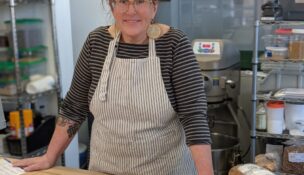

Made in Colorado 2014: Creative/Home/Consumer;
Eric Peterson //April 24, 2014//
Creative / Home / Consumer
 Omerica Organic
Omerica Organic
Body jewelry / omericaorganic.com / Denver
Ryan Lorenz started Omerica Organic in 2004. A decade later, Lorenz says the company is “definitely the largest” manufacturer of wooden earlobe plugs – worn in stretched piercings – in the country.
“I was in the military and served in Iraq and Afghanistan,” he recalls. “When I got out, instead of looking for a job, I started eBaying random things, then I started importing body jewelry and selling it on eBay. I saw a lot of opportunity.”
The opportunity was in making the plugs, not importing them. He started crafting them to order on his parents’ peach farm in Palisade with a lathe and sandpaper, then relocated to Denver in 2005, developed his own website, and started hiring.
Today – about 150,000 plugs later – Omerica employs 11 people in one of the most nimble and innovative manufacturing operations in Colorado. When a customer places an order on the company’s website, it automatically creates a script for a CNC machine to cut the right-sized plug.
“On-demand is a huge thing,” says Lorenz of the custom orders. “Without that type of a business plan, I wouldn’t have been able to make it.”
The company does a good deal of contract work for other brands and recently signed a deal to sell jewelry other than earlobe plugs in Urban Outfitters nationwide.
With 3D printers, laser cutters, CNC machines and more, the Omerica factory “is our largest asset now,” says Lorenz, who at 33, is the oldest Omerican. “We can take an idea and make it live, ready and producing retail sales in two days.”
 Modular Robotics
Modular Robotics
Robotic toy kits / modrobotics.com / Boulder
At Modular Robotics’factory in Boulder, two dozen “elves” crank out all kinds of Cubelets.
The 40-millimeter cubes are akin to smart Legos – some have motors, some have sensors, and all have a tiny computer to communicate with others.
Cubelets were born out of Eric Schweikardt’s thesis project for his Ph.D. in robotics from Carnegie Mellon University in Pittsburgh.
After founding Modular Robotics in 2009, Schweikardt‘s Cubelets struck a chord and the company boomed. In 2012, Cubelets landed $3 million in VC from Foundry Group. Today Modular Robotics employs more than 40 people. “We just shipped Cubelet number 60,000,” Schweikardt touts.
What’s the key to success? You don’t have to be a programmer to make a robot from Cubelets.
Last fall, Modular Robotics launched its second kit, dubbed MOSS. The parts connect via steel balls. “That allows you to do a lot more than just stacking blocks,” says Schweikardt, the company’s CEO. “You can make wings and creepy crawlers and bat wings.”
Engineered to be much less labor-intensive than Cubelets, MOSS kits will underpin 1,000 percent growth to $10 million in sales and a doubling to 85 employees in 2014, Schweikardt projects. “Cubelets was a thesis project that limped its way to be a consumer-electronics product,” he says. “MOSS is a second-generation product that will allow us to scale to that size. It’s more profitable and easier to manufacture.”
Next up for Modular Robotics: entry into new markets. “Imagine robots made out of lots of tiny robots applied to industries other than toys and education,” says Schweikardt.
Fulsus USA
Jackets
Leadville
Michael Collins got burned out on the telecom industry and moved from Tennessee to Leadville to ski a decade ago. But it wasn’t until 2010 that he went into manufacturing and founded Freeride Systems.
He started with webbing-based products for backcountry skiers and snowboarders and quickly moved into outerwear and pants.
In 2013, he got a call from ABC News, looking for a domestically produced jacket for news crews worldwide. Collins landed the contract and founded Fulsus USA to produce jackets for on-air talent. Now in the second phase, he’s outfitted roughly 200 ABC affiliates, and will soon craft jackets for off-air talent as well. In all, Collins expects to make “five figures” of units.
To fill the order, he’s working with a network of 30 to 40 cut-and-sew contractors at any given time and operating perhaps the only seam-taping machinery in Colorado. He expressed curiosity as to whether ABC parent Disney might place future orders – a huge deal for a dinky manufacturer in Leadville.
“The stars kind of lined up, so I took a chance and went ahead and did it,” says Collins. “I don’t know where this goes, but I’m trying to keep it all in Colorado if I can.”
Technology & Electronics
 Wolf Robotics
Wolf Robotics
Robotic welding and fabrication systems
Fort Collins
Wolf Robotics evolved from Heath Engineering, a company that started making equipment for Colorado’s sugar-beet industry in 1944. Over the decades and under several corporate parents, the company moved into custom robotic welding systems and metal fabrication for a wide range of industries.
Spun off as an independent 22-employee company in 2003, Wolf today has 120 employees in Fort Collins, serving a diverse client base.
“Our customers are companies making construction equipment, farm equipment, mining equipment or energy equipment,” says Doug Rhoda, president and CEO, rattling off such blue-chip customers as John Deere and Caterpillar. “It’s the biggest names in each of those segments.”
Wolf serves a largely out-of-state market. “We have some customers in Colorado, but it’s rare,” says Rhoda. “We’re not necessarily close to our customers, so we have to be smarter and better and more responsive.”
Rhoda is quick to credit Wolf’s employees for the company’s success. “First and foremost, it’s the people,” he says. “We’ve got a great team here we’ve developed over the years. In our line of work, it’s all about knowledge.”
And Rhoda sees a domestic manufacturing resurgence in progress, with better technology than the industry that moved offshore since the 1980s. “We will re-shore production, but when we do that, we’re going to automate,” he says.
 Display Devices
Display Devices
Audiovisual equipment / displaydevices.com / Golden
A spinoff from a since-shuttered video-equipment company, Display Devices has been a standalone company since 1991.
President Mervin Perkins says the company got its start selling custom scissor lifts to NORAD to repair projectors in an hour or less.
Clients drove the company’s development into custom audiovisual systems and cutting-edge displays. “They would come to us and say, can you build this?” says Perkins. “The market drives us, rather than the other way around.”
Display Devices has moved from command and control rooms to other projects over the years, including innovative billboards in Times Square for major soft-drink brands and projection systems at Disney’s parks in California and Florida.
“We work with the ‘Imagineers,’” says Perkins of the latter, describing a system with 35 projectors, many of them underwater, for the World of Color show at the California Adventure theme park in Anaheim.
At Disney World in Orlando, Display Devices developed a projection system to change colors and beam advertisements onto the Magic Kingdom Castle. “It used to take 12 guys six weeks to put up Christmas lights,” says Perkins. “Now we can instantly make it any color.”
“So much of what we’ve done is top-secret, never-done-before products,” says Director of Sales David Schmitt of Display Devices’ low profile.
The 50-employee business also does a lot of contract manufacturing for big names like NEC and Hitachi, and even supplies its competitors. Customers of its pan tilts include the White House, the Colorado State Capitol and Cirque du Soleil.
The chameleonic Magic Kingdom technology could be on its way to downtown Denver and displays are popping up everywhere from New York newsstands to Denver’s 16th Street Mall to the roadside near Death Valley.























